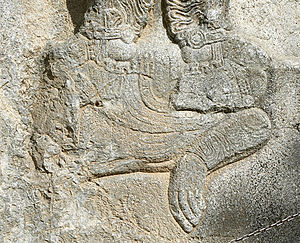Battle of Ctesiphon (363)
| Battle of Ctesiphon (363) | |||||||
|---|---|---|---|---|---|---|---|
| Part of the Julian's Persian War | |||||||
 Detail from a Sassanian relief. |
|||||||
|
|||||||
| Belligerents | |||||||
| Arsacid Armenia | Sassanid Empire | ||||||
| Commanders and leaders | |||||||
| Julian | Merena | ||||||
| Strength | |||||||
| 83,000 men | Unknown | ||||||
| Casualties and losses | |||||||
| Unknown | Unknown | ||||||
The Battle of Ctesiphon took place on May 29, 363 between the armies of Roman Emperor Julian and the Sassanid King Shapur II outside the walls of the Persian capital Ctesiphon. The battle was a Roman tactical victory, although Julian was killed following the subsequent Battle of Samarra and the Roman forces found themselves unable to continue their campaign as they were too far from their supply lines.
On November 3, 361, Constantius II died in the city of Mobsucrenae, leaving his cousin Flavius Claudius Julianus, known to history as Julian the Apostate, as sole Emperor of Rome. Arriving at Constantinople to oversee Constantius' burial, Julian immediately focused on domestic policy and began to greatly reform the Roman Imperial government by reorganizing, streamlining and reducing the bureaucracy.
Turning next to foreign policy, Julian saw the previously unchecked military incursions of Shapur II of Persia against the Eastern Roman provinces as posing the greatest external threat. After many failed earlier attempts, the Persian king launched a more successful second campaign against the Romans and captured Amida in 359, controlling the headwaters of the Tigris and the entrance to Asia Minor from the east. A Roman offensive was desperately needed to halt Shapur.
With Julian's reputation and exploits during his years as Caesar and general of Gaul preceding him, Shapur preferred to negotiate a peace treaty with the intrepid young Julian. Believing it to be incumbent on himself to produce a more permanent settlement in the East, Julian responded to Shapur's calls for peace by saying that the Persian king would be seeing him very soon and began preparing for an expedition against the Sassanid dynasty, collecting all his legions and marching east from Constantinople. Carefully planning and crafting his Persian campaign for over a year, Julian transferred his capital and forward base for the coming war to Antioch, Syria in the summer of 362 and on March 5, 363, set out with 90,000 men while Shapur, along with the main Persian army, spah, was away from Ctesiphon. Per his devised plan of attack, Julian sent 30,000 soldiers under the command of his maternal cousin Procopius to Armenia, with the aim of obtaining support from the King of Armenia for a clever and not looked-for double pincers movement against Shapur.
...
Wikipedia
